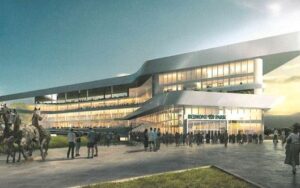
$455M Belmont reboot named as “Project of Regional Significance.”
The Long Island Regional Planning Council has named the $455 million overhaul of Belmont Park as a Project of Regional Significance.
The LIRPC describes Projects of Regional Significance as “projects which can potentially affect the quality of life for Long Islanders in a regionally significant way in areas of economic development, housing, transportation, energy, environment, education, public health, emergency preparedness and social and economic equity.”
The planning council gave the designation after it hosted a presentation Wednesday from developer Michael Dubb, a board member of the New York Racing Association (NYRA) and principal of Jericho-based Beechwood Organization, outlining the plans to modernize the historic horse racing venue and touting the project’s economic benefits. Seven of the LIRPC board members present at the meeting voted unanimously to approve the designation.

Rendering of the Belmont Park redevelopment. / Courtesy of NYRA
The Belmont reboot is expected to generate $1 billion in construction-related economic impact along with 3,700 temporary construction jobs during the project, which began in March. Once completed, it is projected to create $155 million in annual economic impact to the region, along with 700 full-time jobs.
“Through a loan to the New York Racing Association which will be paid at no cost to the taxpayers, the state is making a significant and much-needed investment to modernize Belmont Park, which has a storied place in Long Island’s history and in the world of horse racing” John Cameron, LIRPC chairman, said in a written statement. “We welcome the excitement the new facility will bring to fans and recognize the substantial economic benefits our region will derive.”
The Elmont facility’s redevelopment will right-size its massive and underutilized grandstand and clubhouse. First opened in 1905, Belmont Park was rebuilt in the 1960s and its current 1.25 million-square-foot grandstand, the largest in all of thoroughbred racing, opened in May 1968.
The aging structure is being demolished and replaced with a building that’s less than a quarter of its size, around 275,000 square feet. That will also free up some parkland and allow for expansion of Belmont’s backyard, which had been truncated by the construction of the UBS Arena.
Besides building a smaller, more modern clubhouse and grandstand that will be filled with multiple bars, lounges and dining options, there will be other improvements with the redevelopment. A tunnel will eventually be used to connect fans from the parking lot to Belmont’s 45-acre infield, similar to Churchill Downs, which employs its tunnel for fans to get to the track’s infield on special days like the Kentucky Derby. NYRA will also pursue opportunities to use the 45-acre infield for community events.
In addition, NYRA will add a fourth track to join Belmont Park’s dirt track and two turf tracks. The new track will have a synthetic surface, which Dubb says is similar in feel to grass for the horses but is a much safer surface that should cut down on racing injuries.
The new Belmont building will be winterized to accommodate year-round racing, allowing winter racing and training activities to be moved from Aqueduct. This will also pave the way for the state to develop the 110-acre Aqueduct property in South Ozone Park.
The Belmont Park redevelopment is scheduled to be completed by the end of the summer of 2026 and it’s expected that the Belmont Stakes, which has moved to Saratoga this year and next, will be back at Belmont Park in June 2026.
David Winzelberg //May 15, 2024


